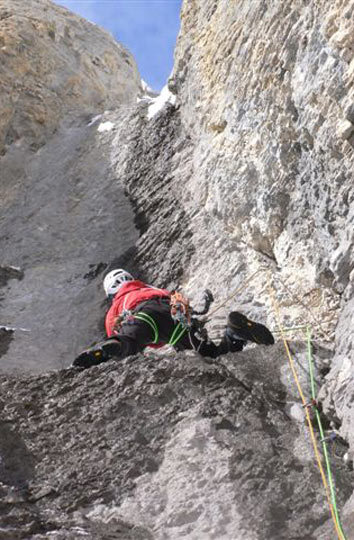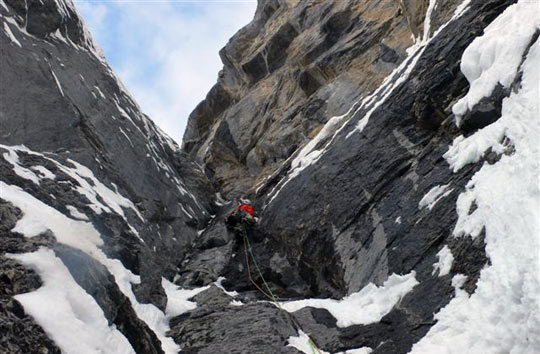
Rob Owens leading Pitch 3 on the first ascent of No Use in Crying (IV M7, 205m) with Jon Walsh on February 13, 2008, Upper Weeping Wall, Canadian Rockies. Owens also established a route on an unclimbed peak in Chickadee Valley, British Columbia, with Eamonn Walsh in October and a new route on the northwest face of Mt. Bell, Alberta, with Steve Holeczi in November. [Photo] Jon Walsh
Over the past four months Rob Owens has been busy in the Canadian Rockies establishing new routes with fellow Canadians: one on an unclimbed peak in Chickadee Valley, British Columbia, with Eamonn Walsh, a new route on the northwest face of Mt. Bell, Alberta, with Steve Holeczi, and a new route on Upper Weeping Wall, Alberta, with Jon Walsh.
On October 26, 2007, Owens and Eamonn Walsh made the first ascent of a line on the north face of a 2680-meter peak that Owens had noticed while ski touring the previous spring in Chickadee Valley, Kootenay National Park. Owens said the line looked great at the time, but he decided to wait until early winter when there would be less snow. The line, Owens-Walsh (IV+ M6+ A1, 600m), consisted of several difficult pitches, including two M6+ lengths with more moderate thin ice and mixed climbing between. The entire route was climbed on natural gear, and only two ice screws were needed from bottom to top. To keep their pace, Owens and Walsh decided to aid a short but physical, overhanging, arching corner roof crack that had no feet to start. Owens reported that the aid pitch was 3/4 up the route and likely would go free at “strenuous M8.” They finished the route in sixteen hours round trip. Owens said they did considerable research to find out if the peak had been climbed before. Finding no evidence that it had, he and Walsh named it Mt. MOG, which stands for Man of Girth, or Part Man, Part Dog.
Two weeks later on November 6, 2007, Owens and Steve Holeczi went after the first ascent of Zeitgeist (IV+ M7- WI5 R, 530m) on the northwest face of Mt. Bell in Banff National Park. Holeczi and Eamonn Walsh had climbed the first five pitches five years earlier. Finding the climbing more difficult than expected, Holeczi and Owens backed off but returned two days later with a larger rack to protect the hard moves on the crux M7- pitch. That day, November 8, they climbed the route in its entirety, needing only one hour to lead the crux instead of the two it had taken them on the 6th. Pleased with the excellent Rockies Quartzite encountered, Owens praised the route’s high quality.
On February 13, Owens and Jon Walsh made the first ascent of No Use in Crying (IV M7, 205m) at one of Alberta’s most classic ice venues: Upper Weeping Wall. Owens noticed the line a month ago and was eager to do something new in this frequented spot, something other than a variation to an already-established climb. “The cool thing about this line is that every seasoned Rockies climber has been on the Weeping Wall, most of us numerous times,” Owens said. “And this line, that likely forms every year, was never looked at.”
In his blog, Owens wrote: “I wasn’t even sure if it had any ice on it but was intrigued enough by the ‘Scottish/Canadian Alpine’ nature of the feature; snow covered rock, just enough cracks for natural protection, and thin splatterings of ice throughout. This is the type of climbing I have grown very fond of lately. Climbs that will be relatively hard, without the need of bolts and that offer the chance of perhaps five-star climbing experiences.”
Owens had not expected much ice, but more than 80 percent of the placements were in ice or ice-filled cracks. The route was sustained, protected solely with natural gear and featured high-quality pitches throughout. Both Owens and Walsh thought it was one of the best winter routes they’d ever done.

Walsh leading Pitch 4 of No Use in Crying (IV M7, 205m). Owens and Walsh agreed that the sustained and naturally protected route was of very high quality and one of the best winter routes they’d ever done. [Photo] Rob Owens